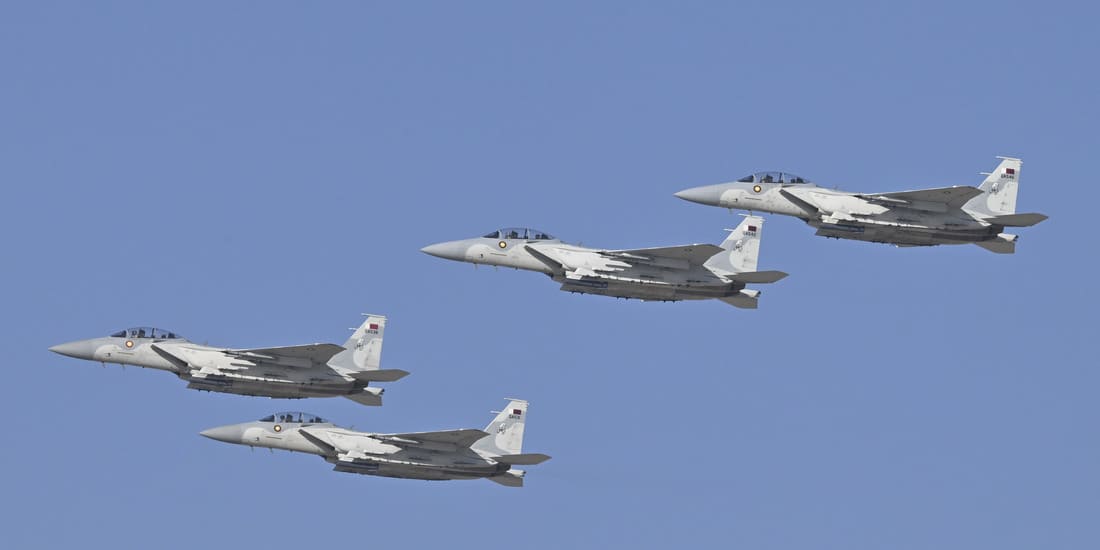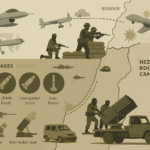On October 10, US Defense Secretary Pete Hegseth announced a Qatari Emiri Air Force training detachment at Mountain Home Air Force Base, Idaho. The site will host F-15QA aircraft and Qatari aircrews for combined training with the US Air Force. Officials confirm Qatar’s defense minister, Saoud bin Abdulrahman Al Thani, attended the signing.
Defense officials called the project a long-planned expansion of an existing partnership that includes Al Udeid in Qatar and years of procurement and training ties. Jurisdiction remains with the United States. Mountain Home already hosts partner training, including Singapore’s F-15 presence. The base and local community know the model.
“I’m proud that today we’re signing a letter of acceptance to build a Qatari Emiri Air Force facility at Mountain Home Air Base in Idaho,” Hegseth said. “It would enhance combined training, increase lethality and interoperability.”
According to officials, the plan runs for 10 years and is funded by Qatar. About 12 F-15QAs and roughly 300 personnel are expected once the site reaches steady state. The schedule links pilot production, range access, and aircraft deliveries and gives both sides a clear framework for recurring training.
Local reaction in Idaho centered on notification and oversight. Public records show senior state offices did not anticipate the announcement date even though the concept circulated in defense channels for years. Lawmakers asked about security vetting, cost shares, and airspace use. Base leaders reiterated that Mountain Home remains a US installation under US command.
Analysts in the Gulf see a training gain and a political signal. “The establishment of the new air base in the US is a strategic move that enhances Qatar’s influence in the United States while simultaneously keeping potential political tensions with the US administration at bay, and strengthening personal ties with [US President Donald] Trump,” said Ali Bakir, a professor at Qatar University.
What the Mountain Home Agreement Includes
The October 10 letter of acceptance sets a Qatari detachment of F-15QA fighters and support personnel at Mountain Home for recurring training and exercises with the USAF. Washington and Doha presented a decade-scale plan, financed by Qatar, to raise combined readiness and standardize procedures across the F-15 enterprise. Officials emphasize this is a hosted training element on an American base under US security rules.
Public figures indicate about 12 aircraft and around 300 personnel when fully manned. Phasing depends on construction, airspace scheduling, and aircraft availability from production lots. Officials say the arrangement will deepen day-to-day interoperability from mission planning to weapons loading and shorten the learning curve for future multinational air operations.
Mountain Home offers extensive military operating areas, instrumented ranges, and units used to working with partners. The base has hosted allied fast-jet training before. US briefers link the facility to a wider effort to expand coalition training capacity inside the continental United States.
Why Qatar Wants US-Based F-15QA Training
Qatar’s fighter fleet grew fast. In 2016, Washington cleared a package for up to 72 F-15QAs, estimated at $21.1 billion. Doha signed for 36 aircraft in 2017. Deliveries began in 2021 and continued into this decade.
According to officials, US-based training lines have operated since early in the program. The Idaho facility formalizes that pattern and gives the Qatari Emiri Air Force a steady venue to cycle pilots, weapon systems officers, crew chiefs, and armament teams through a syllabus aligned with USAF F-15 units.
Qatar’s domestic airspace is tight and busy and sits under heavy civil routes. Western US ranges allow long tactical intercepts, large-force exercises, and routine supersonic work in designated blocks that are harder to schedule over the Gulf. Range control, debrief tools, and air-ground coordination at Mountain Home support advanced fighter training.
Planners tie the campus to specific outputs. Mission data file development. Dissimilar air combat training with US types. Live ordnance events on western ranges. Integrated maintenance instruction on the Advanced F-15’s fly-by-wire systems. Instructors point to the F-15QA’s AESA radar and digital electronic warfare suite and their need for instrumented US range infrastructure. Live, virtual and constructive tools fill gaps when weather or scheduling limits flying and are already standard across the F-15 enterprise.
Sustainment benefits matter. Co-location with US maintenance activity improves fault isolation and software updates and keeps country-unique configurations under agreed controls. Program offices and DCMA teams handled F-15QA acceptance and test events in St. Louis. A stateside training hub aligns with those procedures and keeps logistics predictable.
F-15QA Training Objectives and Range Requirements
The detachment requires high-fidelity simulators, a mission-debrief facility, hush-house engine test cells, munitions storage under US custody, and a parts pipeline linked to the F-15 production line and USAF depots, according to industry sources. Environmental reviews, security contracting, and construction awards run through US channels. Qatar funds the campus. Officials say that setup avoids pressure on US appropriations and still keeps every contract under American law.
Day-to-day integration follows standard practice. Weapons custodians keep Qatari stocks under US rules. Aircrew life-support shops align oxygen systems, survival gear, and ejection seat maintenance with US technical data. Engines and radar line-replaceable units move through American quality systems. Turn times drop compared with shipping each component back to the Gulf.
The export F-15QA brings fly-by-wire controls, an AESA radar, a digital EW suite, and a large-area cockpit display. Instrumented ranges and US test assets support mission-data updates. Instructors highlight the value of dissimilar training with USAF F-35s, F-15E/EX, and F-16s that are routinely available on western ranges. Siting in Idaho cuts transit time and scheduling friction. Units get more sorties and cleaner debrief data.
Political Context and Executive Action
Events in September and early October set the stage for the announcement. After Israel struck Hamas targets in Doha in early September, the White House moved to manage fallout. On October 1, the president signed an executive order stating any armed attack on Qatar would be treated as a threat to US national security and could trigger diplomatic, economic, or military responses. The order did not create a treaty guarantee. It moved beyond Qatar’s 2022 status as a Major Non-NATO Ally.
The Idaho facility gives both capitals a concrete, near-term deliverable under that policy. US leaders framed it as cooperation that also recognizes Doha’s role in mediation. Analysts link the step to a broader effort to steady ties and provide a visible marker after a difficult month.
Domestic politics surfaced. Conservative activists criticized hosting a foreign Arab air arm and cited the 2019 Pensacola shooting by a Saudi trainee. They also questioned Qatar’s regional diplomacy. Idaho officials and members of Congress sought details on notice and security. Pentagon briefers pointed to vetting, range management, and decades of experience hosting partner detachments at US bases.
Industry contacts flag reciprocal benefits. Construction and support contracts land in US states. Qatar gains predictable access to airspace, munitions ranges, and the USAF instructor pipeline. The arrangement complements US access at Al Udeid, which remains the hub for air mobility and command functions in the Gulf. It also sets a reference point for future coalition tasking in and beyond CENTCOM.
Sustainment, Construction and Supply Chain Integration
Procurement history helps explain the schedule. The 2016 notification set a ceiling of 72 F-15QAs with weapons and training. Qatar signed for 36 in 2017. Boeing and the USAF began deliveries in 2021, and public handovers continued through 2024. A permanent US-based training site now gives the fleet a steady place for conversion, continuation, and tactics development.
According to industry sources, the campus build will include simulator bays, secure data rooms for mission data work, and hardened facilities for engines and avionics. Security and access control remain under US authority. Qatar funds the construction package. US law and base rules govern daily operations.
Weapons and sensitive stores stay under US custody. Aircrew equipment shops align standards across both forces. Maintenance debrief and software labs handle F-15QA updates on the same schedules used for US variants where policy allows. Instructors expect routine DACT with USAF fighters on western ranges once the detachment reaches full strength.
The policy climate in Washington around Qatar changed in recent years. The 2022 Major Non-NATO Ally designation formalized a tighter defense link. Some lawmakers debated revisiting that status. The executive branch still treats Qatar as a priority partner for defense trade and basing cooperation. The October order added another layer, even if its legal weight differs from a Senate-ratified treaty.
US-based training is not new to Qatar. The F-15QA program included extensive pre-delivery work in the United States. Acceptance sorties, aerial refueling tests, software checks, and ferry preparations ran for each block. Mountain Home turns episodic activity into a steady program with a set calendar.
Our analysis shows the Mountain Home detachment fits Qatar’s training reality, gives the USAF a consistent way to integrate with a growing partner fleet, and signals firm alignment without changing command authority at the host base.
REFERENCE SOURCES
- https://www.cbsnews.com/news/hegseth-qatar-air-force-facility-us-base-idaho/
- https://www.washingtonpost.com/national-security/2025/10/11/qatar-air-foce-facility-us-idaho/
- https://www.airforcetimes.com/news/pentagon-congress/2025/10/15/air-force-qatar-air-force-facility-in-idaho-in-the-works-for-years/
- https://idahocapitalsun.com/2025/10/16/records-show-idaho-gov-little-sen-risch-werent-aware-qatar-facility-announcement-was-coming/
- https://idahocapitalsun.com/2025/10/14/many-of-idahos-top-officials-mum-on-plans-for-qatari-training-facility-at-mountain-home-base/
- https://apnews.com/article/cdfccbaa4bd4c70c717bf630daf37a89
- https://www.ft.com/content/7d4410d7-1525-42e2-a610-0df13556e3f9
- https://breakingdefense.com/2025/10/qatars-new-training-facility-is-a-strategic-move-for-both-nations-analysts/
- https://www.flightglobal.com/fixed-wing/qatar-and-usa-agree-to-base-f-15qa-fighters-at-mountain-home-afb-in-idaho/164840.article
- https://www.federalregister.gov/documents/2016/11/28/2016-28493/36b1-arms-sales-notification
- https://media.defense.gov/2024/Dec/11/2003606565/-1/-1/0/QATAR_16-58.PDF
- https://boeing.mediaroom.com/news-releases-statements?item=130767
- https://bidenwhitehouse.archives.gov/briefing-room/presidential-actions/2022/03/10/memorandum-on-the-designation-of-the-state-of-qatar-as-a-major-non-nato-ally/
- https://www.reuters.com/business/aerospace-defense/trump-order-pledges-that-us-will-defend-qatar-event-attack-2025-10-01/
- https://www.wsj.com/world/middle-east/trump-signs-order-that-could-see-u-s-military-defend-qatar-2e865361
- https://www.dcma.mil/News/Article-View/Article/4140019/f-15qa-pre-delivery-aerial-refueling-mission-highlights-teamwork/



